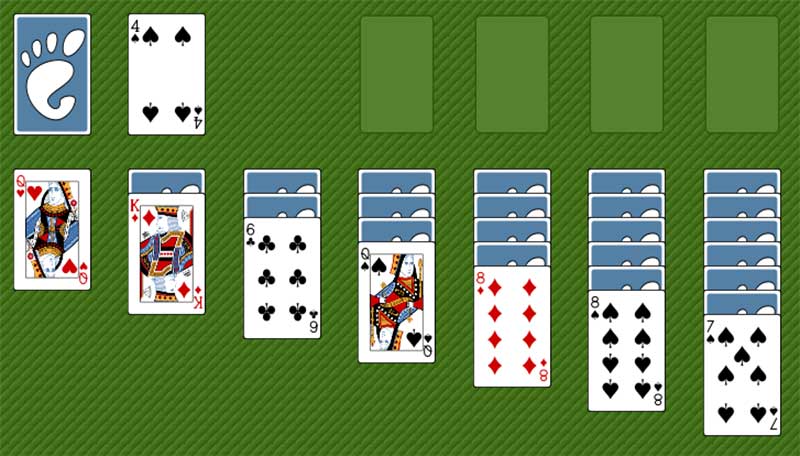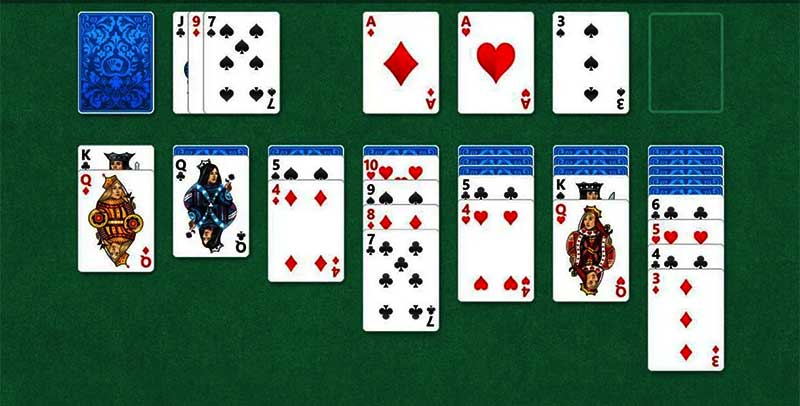Casino Solitaire, a skill-based variant of the traditional card game Solitaire, has found its niche in the realm of online casinos. Unlike the solitary experience of classic Solitaire, Casino Solitaire transforms the game into a competitive and strategic gambling activity.

Casino Solitaire Rules
Casino Solitaire online, a variant of the classic solitaire game, is offered by various online gaming platforms like Cryptologic and Grand Virtual. It’s played with a standard 52-card deck and follows a structure similar to traditional Solitaire, but with added betting elements and modified mechanics that define the official solitaire casino rules. The cards are dealt into 7 columns of ascending length, with the top card of each column face-up, forming the tableau. The remaining cards make up the stock pile, which players draw from throughout the game.
According to standard casino solitaire rules, the objective is to move all cards to the foundation piles, grouped by suit in ascending order, starting with an Ace and ending with a King. Players must follow alternating-color and descending-rank patterns when building sequences in the tableau, creating strategic opportunities to reveal face-down cards and open new moves.
How to Play Casino Solitaire

Solitaire Casino rules involves moving cards from a dealt layout to foundation piles by following specific rules. Here is a step-by-step guide on how to play:
- Place Your Bet: The amount you bet influences your potential winnings.
- Dealing the Cards: The deck is split into two parts: the stock pile and the tableau. The stock pile consists of 24 cards, and the tableau comprises 7 columns with an increasing number of cards from 1 to 7.
- Moving Cards in the Tableau: You can rearrange cards in descending order and alternating colors (red and black) within the columns. Only the top visible card of each column and the stock pile can be moved initially.
- Using the Stock Pile: Draw cards from the stock pile to use in the tableau or move directly to the foundation piles.
- Filling Empty Columns: If a column in the tableau is emptied, it can be filled with a King, starting a new sequence.
- Payouts: You win a fixed amount for each card successfully moved to the foundation piles. The game allows partial payouts without needing to complete the entire deck.
If you’re new to the game, starting with a free Casino Solitaire version of the game is a great way to get acquainted.
Remember, some versions of Solitaire Casino game include an “undo” feature for reversing specific moves, and there are variations in the rules depending on the software or casino offering the game, adding unique challenges and opportunities for players. These variations impact aspects like win ratios, jackpots, column builds, and more. Here are some of them:
- Diverse Win to Bet Ratios: The payout rate varies across different versions of Casino Solitaire. For instance, Kismet and Cryptologic offer a payout of (1 / 10.4) times the bet size for each card moved to the foundation pile. In contrast, Grand Virtual’s version provides a slightly different payout rate of (1 / 11) times the bet size for the same action.
- Jackpot Opportunities: Kismet Jackpot Vegas Solitaire introduces a progressive jackpot bonus. This jackpot is triggered when a player successfully relocates all 52 cards to the foundation piles. The amount of this jackpot fluctuates over time and is influenced by the size of the player’s initial bet.
- Column Build Rules: Grand Virtual’s Vegas Solitaire has a distinct rule regarding column manipulation. In this version, players cannot partially move a column; they must either relocate the entire column or none of it. This differs from other versions, where breaking up a column for individual card moves is permitted.
- Restrictions on Moving Cards Off Foundations: Another unique rule in Grand Virtual Vegas Solitaire is the restriction on moving cards from the foundation piles back to the columns. This contrasts with other versions of the game, where such moves are allowed, providing more flexibility in gameplay.
- Cards Per Draw Variations: Typically, Casino Solitaire games involve drawing one card at a time from the stock pile. However, Grand Virtual offers a “3-card” draw option. In this mode, players draw three cards at once but can only use the top card of the trio. The player can cycle through these cards up to three times.
- Golf Solitaire Variant: Grand Virtual also presents “Golf Solitaire,” a variant where players aim to place cards in an extended sequence of ascending or descending ranks. A payout is awarded if at least 48 out of the 52 cards are successfully sequenced.
| Rules | Grand Virtual | Kismet Jackpot Vegas Solitaire | Cryptologic Casino Solitaire | 3Dice Solitaire | Cryptologic Draw Three Solitaire | |||
| 1-Card Casino Solitaire | 1-Card Vegas Solitaire | 3-Card Casino Solitaire | 3-Card Vegas Solitaire | |||||
| Column Builds | Yes | No | Yes | No | Yes | Yes | Yes | Yes |
| Move Cards off Foundations | Yes | No | Yes | No | Yes | Yes | Yes | Yes |
| Cards per Draw | 1 | 1 | 3 | 3 | 1 | 1 | 3 | 3 |
| Win: Bet Ratio | 4.7 | 5.2 | 3.8 | 4.3 | >5.0 (depends on size of jackpot) | 5.0 | 5.0 | 4.0 |
Casino Solitaire Strategy
Mastering solitaire casino games requires more than following basic rules — it demands foresight, probability awareness, and efficient card management. If you want to elevate your casino solitaire strategy and increase your chances of winning while you play Casino Solitaire, these expert-level techniques will help you get ahead.
1. Prioritize Moves That Reveal Hidden Cards
In every solitaire casino game, uncovering face-down cards should be your primary objective. Moves that reveal new cards often lead to additional sequences or foundation moves.
Why it works:
More available cards = more options, especially in tight endgame scenarios.
2. Build Long, Flexible Sequences in the Tableau
When you play Casino Solitaire, avoid scattering cards into short stacks unless absolutely necessary. Try to maintain long descending sequences that alternate colors.
Benefits:
- Enables more complex rearrangements
- Reduces deadlocks later in the game
- Helps manage Kings efficiently in empty columns
3. Don’t Move Cards to Foundations Too Early
In many solitaire casino game variants, prematurely sending low-rank cards (Aces, 2s, 3s) to the foundation can limit your tableau flexibility.
Advanced tactic:
Only send cards to foundations when doing so doesn’t block future sequences. Holding off often opens multiple stronger plays.
4. Use the Stock Pile Strategically (Especially for 3-Card Draw)
In 3-card draw versions, cycling the stock effectively is one of the most critical aspects of casino solitaire strategy.
Tips:
- Count how many cycles are allowed
- Memorize discard order to anticipate future draws
- Time your tableau shifts right before good stock cards appear
This strategy is especially important when you play Casino Solitaire versions like Cryptologic Draw Three Solitaire.
5. Track High-Value Cards and Discards
In every solitaire casino game, tracking low-ranked cards (Aces, 2s, 3s) is crucial. Once discarded or hidden deep in the tableau, they can block entire foundation piles.
Pro tip:
After several rounds of solitaire casino play, you’ll naturally develop a sense of “card awareness” — which dramatically improves your win rate.
Side Bets in Casino Solitaire
Look for the plus sign (+) next to the casino chips to add a side bet. Each chip displays an amount indicating the side bet’s value. In Casino Solitaire, you have the option to choose from three different side bets. If you wish to cancel a bet, simply select the minus sign (-) to remove your choice.
First Side Bet: No Moves
Located to the left of the ‘Start’ button, the first side bet is labeled “SIDE BET 1 – NO MOVES.” Here, you have three betting options: 1, 2, or 3. This bet pays off if, after the initial card distribution in Casino Solitaire, no moves are possible. This includes an inability to move cards within the “Tableau” and the “Talon.” If you hit “NO MOVES,” your bet is multiplied by 15.
- Betting Option 1: 1 x 15 = 15
- Betting Option 2: 2 x 15 = 30
- Betting Option 3: 3 x 15 = 45
Second Side Bet: Red or Black
The second side bet, “SIDE BET 2 – RED OR BLACK,” is found to the right of the ‘Start Solitaire’ button. The stakes for this bet are 0.25, 0.50, or 1. The outcome is determined at the game’s start, similar to the first side bet. This bet wins if all cards, including the seven on the tableau and the face-down card from the stockpile, are of the same color. A winning bet here is rewarded with 200 times your stake.
- Betting Option 1: 0.25 x 200 = 50
- Betting Option 2: 0.50 x 200 = 100
- Betting Option 3: 1.00 x 200 = 200
In each new round of Casino Solitaire, you have the opportunity to place these side bets. Remember, it’s your responsibility to make these selections. Failing to choose a side bet means you won’t have a bet in place and thus no chance of winning. The choice of whether to bet on one or both side bets rests solely with the player.
Strategy Overview
While a perfect strategy is not established due to the game’s inherent randomness, certain practices can improve your chances of winning. Here are some key strategic tips:
- Use Foundation Pile Cards Wisely: When you’re stuck, consider pulling cards from the foundation pile, especially when you’re close to winning. This can open up new moves and possibilities.
- Plan Ahead: Always try to think several moves in advance. This foresight helps in creating opportunities for future moves and avoiding potential dead-ends.
- Track Discards: Pay attention to the discards, especially crucial low-ranked cards. Knowing what has already been played can inform your decisions about future moves.
- Be Cautious with Column Clearing: Avoid clearing a column unless you have a king ready to place there. This ensures that you don’t limit your options for future moves.
Remember, while strategy plays a role, luck is also a significant factor in the game’s outcome. We recommend using our calculators, such as Mines calculator, and Stake Dice calculator, in relevant games where probability calculation can play an important role in choosing the winning strategy.
FAQ
The house edge varies depending on the game version and the player’s strategy. In general, it ranges from a small player edge to about 4.5% in favor of the house.
The game’s variance is relatively low, similar to baccarat, and less than blackjack. Most sessions result in a net payout between 40% and 100% of the original bet size.
Yes, there are several variations, including different win rates, restrictions on moving cards, and variations in the number of cards drawn from the stock pile.
The undo feature’s availability and function vary by software. Some allow undoing the last move, while others have more limitations.

